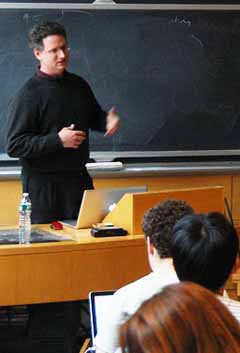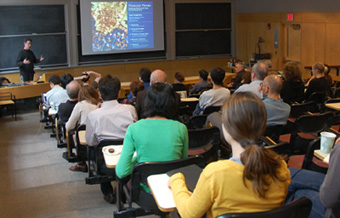Gael McGill spoke on Friday May 6th as part of the ongoing Biology Education Group series, co-sponsored by the Biology department and OEIT.
Dr. McGill's research uses bio-visualization as a way to communicate cell data in 3 dimensional space, and he presented on the work he has done leveraging the powerful animation tools used in Hollywood movies produced by Disney and Pixar.
 3D animations of micro biological processes offer unique opportunity to merge the work of structural biologists, who use algorithms to understand neural networks, with the work of systems biologists who study cell construction and growth.
3D animations of micro biological processes offer unique opportunity to merge the work of structural biologists, who use algorithms to understand neural networks, with the work of systems biologists who study cell construction and growth.
McGill shared some of the challenges and difficulties encountered when creating 3D animations of microbiologic processes. Because the processes are at the atomic level, they exist below the wavelengths of light. Choices must be made as to what colors to use in the animation, and artistic and pedagogical considerations need to be taken into account. In addition, choices need to be made as to which data to feature, and which data to exclude, because if all data is portrayed, it is impossible to 'see' anything. Another challenge concerns situations where there is incomplete structural data. At what point is one ready to create a visualization? What is included, what is taken out?
 McGill and his colleagues have adapted Maya, one of the best 3D animation tools in the industry, for molecular visualization. Dubbed MolecularMaya, the new application integrates the Rutgers Protein Data Base into Maya's code base so that users can more easily create molecular animations without having to build from scratch. And with Maya recently made free to the academic community, it is predicted that this area will experience much growth in creative output.
McGill and his colleagues have adapted Maya, one of the best 3D animation tools in the industry, for molecular visualization. Dubbed MolecularMaya, the new application integrates the Rutgers Protein Data Base into Maya's code base so that users can more easily create molecular animations without having to build from scratch. And with Maya recently made free to the academic community, it is predicted that this area will experience much growth in creative output.
Of particular interest was molecularmovies.org, a site that collects the best molecular cell movies online. With resources organized by topic, one can search on areas of interest. The site also houses the source software, and thus visitors can download the software, embed it with Maya and begin their own animations. With over 200 pages of free tutorials, the site is a comprehensive resource for those wanting to learn how to create their own molecular animations.